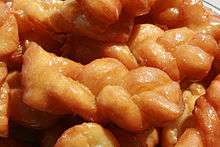Koeksister
 | |
| Type | Doughnut |
|---|---|
| Place of origin | South Africa |
| Main ingredients | Dough, sugar syrup |
|
| |
A koeksister (or koe'sister) derives from the Dutch word koekje, which translates to "cookie".[1] There are two popular versions of this South African syrup-coated doughnut: an Afrikaner version which is a twisted or braided shape (like a plait) and a Cape Malay version which is a spicy treat finished off with a sprinkling of coconut. It is prepared by deep-frying plaited dough rolls in oil, then dipping the fried dough into cold sugar syrup. Koeksisters are very sticky and sweet and taste like honey.[2]
Koeksisters are of Cape Malay origin,[3] among whom they were known as koe'sisters, apparently suggesting polite gossiping among spinsters.[4] The Afrikaner version is much more syrupy and crisp, while the Cape Malay version is an oval, fried dumpling with a texture more akin to a cake. The dough includes yeast and is spiced with powdered cinnamon, aniseed, cardamom and ginger. It is deep fried, then placed in hot syrup and finally rolled or sprinkled in dried coconut.
_(2).jpg)
A monument of a koeksister in the Afrikaner enclave of Orania recalls a folk tradition of baking them to raise funds for building of churches and schools.[4]
Both versions, the Afrikaner koeksister and the Cape Malay koesister, have sparked a home industry environment in South Africa. It is not uncommon to see the plaited koeksister sold at intersections. Cape Malay households sell the koesister by the half-dozen or dozen on Sunday mornings as a Sunday morning breakfast treat, enjoyed with a mug of coffee.
Recently, South African commercial chain-department stores like Woolworths and retail supermarkets like Checkers have stocked the Afrikaner version of the koeksister. Competitions were also held in 2014 to find the best koeksister in the country.
See also
References
- ↑ Bradford, Jean (1978). A Dictionary of South African English. Oxford.
- ↑ Laurens van der Post (1970) African Cooking, Time-Life Books, New York
- ↑ Green, Lawrence (1949). "Chapter 4 - Country Hospitality". In the Land Of Afternoon. Howard Timmins.
- 1 2 Wybenga, Wim (2008-05-01). "Koeksister het sy eie monument op Orania". Volksblad. Retrieved 8 November 2012.
5. [1]
External links
- Duckitt, Hildagonda J (1891). "KOESISTERS". Hilda's "where is it?" of recipes. London: Chapman and Hall.
| ||||||||||||||||||
- ↑ Koeksister Competition to find best Koeksister in 2014